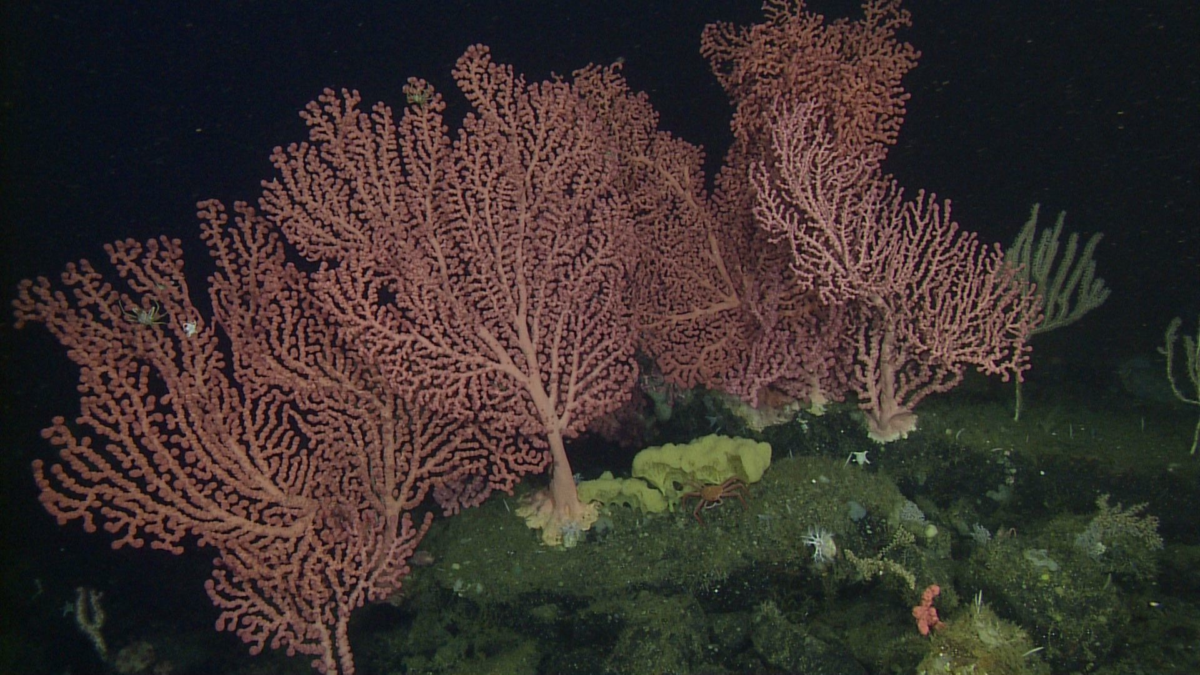If one has ever been to the beach, they’ve probably felt small compared to the ocean. In fact, only 5% of the world’s oceans have been explored at this time, so people have barely scratched the surface in terms of ocean exploration. Much of the ocean is a mysterious abyss, full of species not yet discovered and geological structures unlike anything the average human eye has seen. This includes the deep ocean, or benthic zone of the ocean, which some believe is less explored than the Moon.
The deep ocean is broadly characterized as any area of the ocean below 200 meters in depth. Many organisms bioluminesce (produce and emit their own source of light). Consumers also rely on falling detritus (waste) derived from dead surface organisms, or marine snow. Additionally, much of deep sea life is sustained by hydrothermal vents. Hydrothermal vents are chimney-like structures that form where seawater and magma meet, and occur when seawater perlocates (seeps without a defined channel) below the ocean floor in subduction zones or spreading centers. There are two main types: black smokers, which are made of iron sulfide and appear black, and white smokers, which are made of silicon, barium and calcium, appearing white. Both serve as a home for microbes (microorganisms) that perform chemosynthesis, or produce energy, using the chemicals from these vents in a process similar to photosynthesis. The deep sea is also home to cold seeps, which are composed of cold hydrogen sulfide or methane seeping out of the ocean floor sediment, serving as a similar source of chemosynthesis for primary producers. Because of their chemosynthetic potential, hydrothermal vents and cold seeps are able to support a variety of deep sea life.
Despite the deep ocean’s drastically different ecosystems and processes from anything resembling human life, it has great effects on the regulation of anthropogenic processes like climate change. Overall, the ocean absorbs about 93% of excess atmospheric heat. The deep sea acts as a major carbon sink, storing about 38,000 Gt of carbon, or about sixteen times as much as the terrestrial biosphere. Deep sea microbes also consume methane released from hydrothermal vents and cold seeps, converting it into hydrate caps and keeping it from entering the atmosphere. Methane is a greenhouse gas whose climate impact over 100 years is 25 times that of CO2, so the role of these microbes is important. Additionally, zooplankton (plankton that don’t produce their own food) biomass indirectly depends on deep sea seeps and vents help fertilize the ocean, leading to higher biodiversity on the global marine scale.
Unfortunately, the benthic environment is not exempt from the effects of climate change itself. For example, abyssal temperatures are highly stable, but nevertheless could warm by up to 1 degree Celsius by 2100. As ocean temperature increases, hydrate caps of methane and CO2 could dissolve. If enough of these greenhouse gases were released, the effects on the entire planet would be horrific. In one Pacific hydrate-capped CO2 reservoir, the rate of CO2 bubbles coming out of the seafloor was equivalent to 0.1% of CO2 emitted on the whole Mid Ocean Ridge (the largest seafloor mountain chain on Earth, stretching 40,390 miles), which stresses the catastrophic potential effect on our planet these greenhouse gas caps contain.
Many areas of benthic ecosystems, such as abyssal plains, are also short of food, and global human-induced processes such as warming and ocean acidification are expected to increase these food shortages. Similarly, fewer decaying marine organisms falling to the bottom also could lead to food shortages in benthic ecosystems. Also, increases in surface water temperature lead to a decrease in mixing of surface and deep waters, which could result in a decrease in ocean productivity. Cooler waters have a greater potential for nutrient storage, and reduced upwelling (rising seawater) zones lead to smaller surface levels of oxygen, which is reducing habitats for species such as marlin and tuna. Fishing processes such as bottom trawling (dragging nets along the seafloor) are detrimental to benthic habitats and have potential to destroy hydrothermal vents and cold seeps, reducing species diversity in human-regulated areas and fisheries. Despite its cooler water, the deep ocean itself is not exempt from oxygen loss, resulting in decreased organism fitness and loss of habitat. As humans become more aware of deep sea environments (hydrothermal vents were only discovered about forty-five years ago) accelerating ocean exploration and mining threatens to interfere with their structure.
Climate change has made it thousands of meters to the seafloor, threatening to overwhelm even these ecosystems and destroy their important role in greenhouse gas storage and nutrient cycling. Deep sea habitats may not rely on the same source of energy as humans, but despite their mysticism, they are vulnerable to the same global processes. Therefore, it is crucial for the long term survival of the planet to support MPAs (Marine Protected Areas) and avoid bottom trawling and deep sea mining.
Sources:
“CO₂ Reservoir ” World Ocean Review.” World Ocean Review, worldoceanreview.com/en/wor-1/ocean-chemistry/co2-reservoir/.
Levin, L. “Sustainability in Deep Water: The Challenges of Climate Change, Human Pressures, and Biodiversity Conservation.” Oceanography, vol. 32, no. 2, 2019, pp. 170–180., doi:10.5670/oceanog.2019.224.
“The Deep Sea: a Key Player to Be Protected for Climate and Ecosystems.” Ocean & Climate Platform, 30 Jan. 2020, ocean-climate.org/en/awareness/the-deep-sea-a-key-player-to-be-protected-for-climate-and-ecosystems/.
“The Deep Sea ~ MarineBio Conservation Society.” MarineBio Conservation Society, 21 Jan. 2021, marinebio.org/oceans/deep-sea/.
Thurber, A. “Hydrothermal Vents, Methane Seeps Play Enormous Role in Marine Life, Global Climate.” Life at OSU, 5 Oct. 2017, today.oregonstate.edu/archives/2016/may/hydrothermal-vents-methane-seeps-play-enormous-role-marine-life-global-climate.
US Department of Commerce, National Oceanic and Atmospheric Administration. “What Is a Hydrothermal Vent?” NOAA’s National Ocean Service, 1 Feb. 2009, oceanservice.noaa.gov/facts/vents.html.
US Department of Commerce, National Oceanic and Atmospheric Administration. “What Is Bioluminescence?” Ocean Exploration Facts: NOAA Office of Ocean Exploration and Research, 5 Mar. 2013, oceanexplorer.noaa.gov/facts/bioluminescence.html.
Waller, R., Shank, T. “Deep Sea Biology.” Dive & Discover, divediscover.whoi.edu/hot-topics/deepsea/.
Woody, Todd. “Greenhouse Gases Hidden at the Bottom of the Oceans Could Make Warming Far Worse.” Science, National Geographic, 10 Feb. 2021, http://www.nationalgeographic.com/science/article/greenhouse-gases-lurk-in-oceans-could-make-warming-far-worse.

